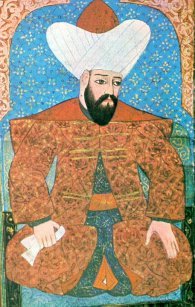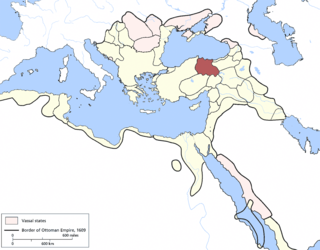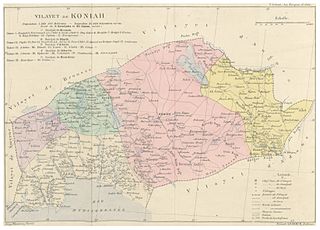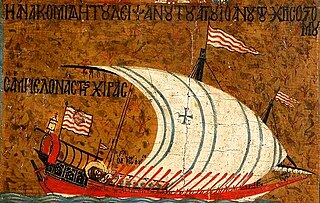Karasi may refer to:

Orhan Ghazi was the second sultan of the Ottoman Empire from 1323/4 to 1362. He was born in Söğüt, as the son of Osman I.

A sanjak was an administrative division of the Ottoman Empire. The Ottomans also sometimes called the sanjak a liva from the name's calque in Arabic and Persian.

The Eyalet of Rûm, later named as the Eyalet of Sivas, was an eyalet of the Ottoman Empire in northern Anatolia, founded following Bayezid I's conquest of the area in the 1390s. The capital was the city of Amasya, which was then moved to Tokat and later to Sivas. Its reported area in the 19th century was 28,912 square miles (74,880 km2).

Eyalets, also known as beylerbeyliks or pashaliks, were the primary administrative divisions of the Ottoman Empire.

Anatolian beyliks were small principalities in Anatolia governed by beys, the first of which were founded at the end of the 11th century. A second and more extensive period of establishment took place as a result of the decline of the Seljuq Sultanate of Rûm in the latter half of the 13th century.

The Germiyanids was a prominent Anatolian beylik established by the Oghuz Turkish tribes after the decline of Sultanate of Rûm. However, while the beylik was always mentioned as Turkoman or Oghuz Turkish, the population consisted of Turks and Yezidi Kurds, brought by the Seljuks from the east of Malatya to western Anatolia as militia guards against the threatening Turkish tribesmen.

The Karasids or Karasid dynasty, also known as the Principality of Karasi and Beylik of Karasi, was an Anatolian beylik in the area of classical Mysia from ca. 1297–1345. It was centered in Balıkesir and Bergama, and was one of the frontier principalities established by Oghuz Turks after the decline of the Seljuk Sultanate of Rum.

The Vilayet of Konya was a first-level administrative division (vilayet) of the Ottoman Empire in Asia Minor which included the whole, or parts of, the ancient regions of Pamphylia, Pisidia, Phrygia, Lycaonia, Cilicia and Cappadocia.

Hamidids or Hamed Dynasty also known as the Beylik of Hamid, was one of the 14th century Anatolian beyliks that emerged as a consequence of the decline of the Sultanate of Rum and ruled in the regions around Eğirdir and Isparta in southwestern Anatolia.

The Vilayet of Aidin or Aydin also known as Vilayet of Smyrna or Izmir after its administrative centre, was a first-level administrative division (vilayet) of the Ottoman Empire in the south-west of Asia Minor, including the ancient regions of Lydia, Ionia, Caria and western Lycia. It was described by the 1911 Encyclopædia Britannica as the "richest and most productive province of Asiatic Turkey".
Ishak Bey Kraloğlu, christened Sigismund Tomašević, was a Bosnian prince, a younger half-brother of the King Stjepan Tomašević, and the last known member of the House of Kotromanić. He became an Ottoman statesman after growing up at the Porte in Istambul.
Hacı İlbey was an Ottoman commander during the early years of the empire.
Ali Bey Evrenosoğlu or Evrenosoğlu Ali Bey, known simply as Ali Bey, was an Ottoman military commander in the 15th century. He was one of the sons of Evrenos, an Ottoman general. During the 1430s he was sanjak-bey of the Sanjak of Albania who, after initial defeats, suppressed the Albanian Revolt of 1432–1436 with help of the forces commanded by Turahan Bey. In 1440 he participated in the unsuccessful Ottoman Siege of Belgrade.
Karasi Bey, attested as Carases by Nicephorus Gregoras, was Bey of the Karasids in northwestern Anatolia.

The Sanjak of Biga was a second-level Ottoman province, roughly corresponding to the modern Çanakkale Province of Turkey.

The Battle of Adramyttion occurred in autumn 1334 between the fleets of a Christian naval league, headed by the Republic of Venice and the Knights Hospitaller, and of the Turkish beylik of Karasi. The battle was a Christian victory.
Artuklu is another name of the Artuqids, a dynasty in Anatolia.

The Çapanoğlu dynasty, also Cebbarzâdeler, Çaparzâdeler and Çaparoğulları, is Turkish dynasty that originates in the 17th-century Ottoman Empire and was once one of the most prominent Ottoman families. They became one of the most powerful dynasties in the empire in the 18th century.

Süleyman Bey or Capanoğlu Süleyman Bey was an Ottoman military leader and office holder from the Çapanoğlu family, one of the most powerful Ottoman dynasties of the 18th century. Under his guidance the family reached its peak of prominence.
Çapanoğlu Mustafa Ahmed Pasha was a prominent Ottoman officeholder and a member of the Çapanoğlu family, which he led after the death of his father Ahmed. Among his accomplishment are the construction of the baroque, domed Çapanoğlu Mosque in his native Yozgat, founded by the family.